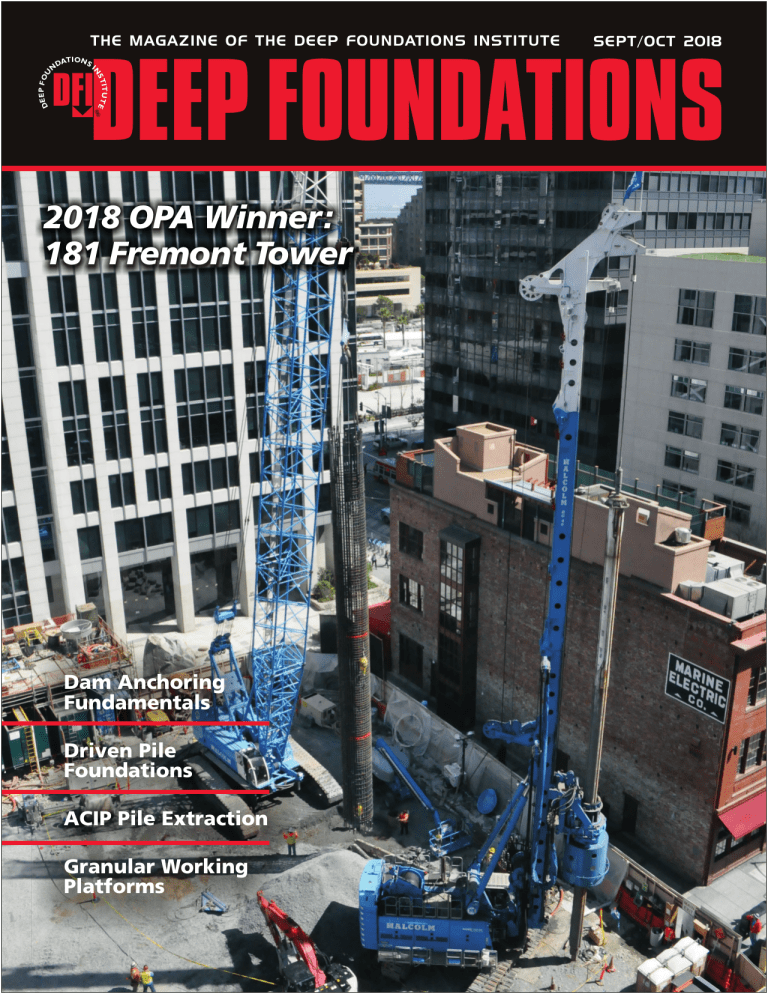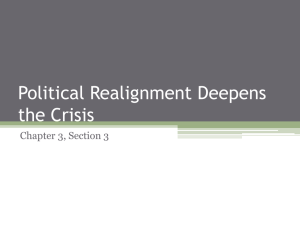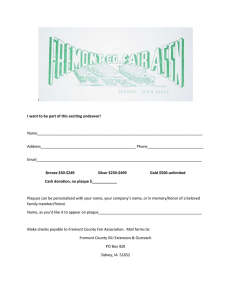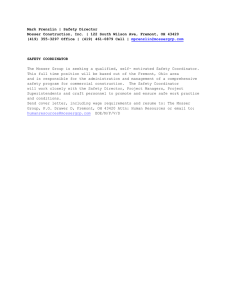
N SEPT/OCT 2018 DEEP FOUNDATIONS N DFI ITUTE ST EP FO U DE THE MAGAZINE OF THE DEEP FOUNDATIONS INSTITUTE TIONS DA I ® ® 2018 OPA Winner: 181 Fremont Tower Dam Anchoring Fundamentals Driven Pile Foundations ACIP Pile Extraction Granular Working Platforms 2018 OPA WINNER 181 Fremont – Very Deep Foundations at a Dense Urban Site COVER STORY The 181 Fremont Tower is an iconic, new, mixed-use high-rise in the dense urban setting of downtown San Francisco, Calif., that celebrated its grand opening in May 2018. With a roof level at a height of 702 ft (214 m) and an architectural spire topping out at a height of 802 ft (244.5 m), the 57-story tower is the tallest mixed-use building west of the Mississippi. The below grade components for the tower include a five level, 58 ft (17.7 m) deep basement and 42 drilled shafts extending to depths of approximately 260 ft (79.2 m) below street grade. At the time of construction in 2014, the drilled shafts were the deepest in San Francisco and helped to set a new precedent for supporting heavy structures on bedrock in a part of the city where large building settlements have been known to occur. As discussed in this article, the design and construction of the basement and shafts deftly navigated a variety of difficult site conditions and constraints, such as loose fill and soft soils, shallow groundwater, a small project site in a dense urban setting, the close proximity of other buildings, and the ongoing excavation and build-out of the adjacent Salesforce Transit Center. Photo of 181 Fremont Tower with mega-braces shown (permission from Jay Paul Company) The Salesforce Transit Center to the north is approximately 165 ft (50.3 m) wide, 60 ft deep (18.3 m) and extends for four city blocks. The above-grade portion consists of a bus-deck level and a rooftop garden, while the below-grade portion consists of an underground trainbox. Due to the shallow groundwater table and the relatively light weight of the transit center, its foundation consists of a mat with Site Location and Constraints The site is bounded by the Salesforce Transit Center (former Transbay Transit Center) to the north, the 199 Fremont building to the east, the historic “Townhall” building to the south and Fremont Street to the west. AUTHORS Satellite image of the 181 Fremont Tower site (Google Earth) Kirk Ellison, Ph.D., P.E., G.E., Arup North America; Eric S. Lindquist, Ph.D., P.E., Brierley Associates; Peter Faust, Dipl.-Ing. Malcolm Drilling Company 14 • DEEP FOUNDATIONS • SEPT/OCT 2018 micropile tie-downs. At the time of construction of the 181 Fremont Tower, excavation and build-out of the trainbox was underway. The support of excavation for the trainbox consisted of a cement deep soil mixed (CDSM) cut-off wall supported by four levels of temporary walers and cross-lot braces. The 181 Fremont shoring system shared the CDSM wall for the transit center on one side. The 364 ft (111 m) high, 27-story 199 Fremont building to the east has four basement levels extending to a depth of approximately 50 ft (15.2 m) below the ground surface. Due to its close proximity to the 181 Fremont excavation, the shoring wall for the 181 Fremont basement was placed directly adjacent to the existing abandoned shoring wall for the 199 Fremont basement. The Townhall building (also known as 342 Howard Street or the Marine Electric building) to the south is separated from the 181 Fremont Tower by a narrow walkway that provides access to the 199 Fremont building from Fremont Street. The Townhall building is a three-story masonry building (that has undergone a seismic upgrade) with a one level basement bearing on strip footings with timber piles. Finally, Fremont Street to the west is a particularly busy roadway that provides access to a large portion of the city from the I-80 off-ramp near the end of the San Francisco Bay Bridge. Geology and Subsurface Conditions The project site is located near the edge of the San Francisco Bay and was formerly part of the historic Yerba Buena Cove prior to its reclamation in 1853. Thus, soils underlying the site consist of alluvial sand and clay deposits that alternate due to past depositional changes at the bay margin. that is relatively homogeneous and slightly overconsolidated. The Old Bay Clay is underlain by a very stiff clay with interbedded sands and gravels that are terrestrial, colluvial, fluvial and possibly estuarine in origin. This layer is referred to herein as “Valley Deposits,” since the presence of some cobbles and large pieces of wood indicate that debris flows likely filled a valley that once existed at the site between Rincon Hill to the south and Telegraph Hill to the north. Franciscan Complex Bedrock was encountered under the Valley Deposits at depths ranging from approximately 222 to 236 ft (67.7 to 71.9 m). In this part of the city, the Franciscan Complex consists of a chaotic mixture of competent blocks of sandstone, siltstone and sheared shale floating within a softer clayey mélange matrix. Very Deep Foundations The foundations for the 181 Fremont Tower consist of 17 ea 5 ft (1.5 m) diameter drilled shafts, 25 ea 6 ft (1.8 m) diameter shafts, a 3 ft (0.9 m) thick mat, and an 8 ft (2.4 m) wide by 12 ft (3.7 m) deep pile cap ring beam that ties together 34 of the drilled shafts located along the perimeter of the structure. As the mat rests on compressible Bay Mud and the deep shafts provide relatively rigid support to the structure, the thin mat was able to be designed primarily to resist hydrostatic uplift and a small heave load. Design of the Drilled Shafts Drilled shafts to bedrock were identified at an early stage of design as the preferred foundation solution for several reasons: 1. Large seismic demands necessitate the transfer of loads to great depths to provide adequate resistance. 2. Net unloading due to the excavation and build-out of the adjacent transit center could otherwise enable movement along a slip surface type mechanism extending from the southern edge of the tower to the northern edge of the transit center while passing through the bottom of the Valley Deposits. 3. Case studies from nearby sites indicated that shallower pile systems can mobilize creep settlement of the lightly overconsolidated Old Bay Clay under heavy loading. Plan view of the deep foundation system and contours of depth to bedrock (in ft) The fill material in the upper approximately 15 ft (4.6 m) is underlain by interbedded marine deposits consisting of soft to stiff clays (Bay Mud) and medium dense to dense sands (marine sands) to a depth of approximately 85 ft (25.9 m). The interbedded marine deposits are underlain by a stiffer marine clay known as Old Bay Clay (or Yerba Buena Mud) to a depth of approximately 165 ft (50.3 m) Unlike many conventional high-rise buildings, the primary structural system for resisting wind and seismic loads at the 181 Fremont Tower relies on mega-braces located at the exterior of the structure rather than a more conventional reinforced concrete core. This enables the structure to function with a more open floor plan, which is desirable given the small footprint of the site; however, it also tends to concentrate large dynamic loads at the corners of the foundation. Due to the proximity of the property boundary, pile groups placed at the corners would have been subjected to large eccentric loading. Instead, the potential for differential settlement due to plunging of the corner shafts was mitigated by tying the exterior shafts together with the pile cap ring beam. Integral to the design process was the construction of a test shaft that was loaded via bi-directional expansion of a cluster of three hydraulic load cells (i.e., Osterberg cells or O-cells) positioned within the rebar cage approximately 20 ft (6.1 m) from the shaft tip. The test shaft was not sacrificial and was able to be incorporated as a DEEP FOUNDATIONS • SEPT/OCT 2018 • 15 Interpreted drilled shaft capacity with depth Base slab installation and connection to the drilled shaft foundation system permanent foundation element at a relatively lightly loaded location with little uplift demand. The design side friction (i.e., the slope of the line on the load-elevation plot), which was assumed to develop within the bedrock, is approximately half of the amount that was demonstrated to develop during the load test. This is to account for the possibility that the chaotic arrangement of competent blocks within the Franciscan Complex Bedrock could have contributed to a high capacity at the test shaft that should not be relied upon elsewhere. However, the higher side friction was permitted at a few locations where the presence of intact sandstone made for particularly difficult drilling conditions. The diameter and length of each drilled shaft was selected to achieve the required ultimate capacity based on the subsurface conditions at the shaft. Thus, on-site observation by the design engineering staff was critical to identify the material encountered during excavation of each shaft so that its tip depth could be shortened or lengthened as required. Despite the small building footprint, the variation in stratigraphy across the site was significant. For example, the depth to bedrock varied by as much as 14 ft (4.3 m) across the site. The bedrock contours were updated and distributed regularly during construction to aid in the estimation of required tip depth (and rebar cage length) for subsequent shafts. Construction and Integrity Testing of the Drilled Shafts Malcolm Drilling installed the drilled shafts from the existing grade using a Bauer BG46 drill rig with a 263 ft (80.2 m) long Kelly bar. Since the overburden soil layers consisted of 16 • DEEP FOUNDATIONS • SEPT/OCT 2018 loose manmade fill, including old wooden piles, and several sand lenses to depths of about 80 ft (24.4 m), temporary steel casing was used to stabilize these layers during construction. Drilling beyond the casing in the mostly stiff clay layers proceeded using polymer slurry (i.e., drilling support fluid). The Valley Deposits were believed to pose a significant risk to borehole stability due to their loose matrix of gravel and cobble components. Therefore, a higher-grade KB polymer was used because the product allows for immediate slurry enhancement with stabilizing additives when loose soil layers are encountered. Since the small site (140 by 130 ft [42.7 by 39.6 m] in plan) is in San Francisco’s financial district and at least two other major construction projects were underway throughout construction Aerial view of the small project site (i.e., Salesforce Transit Center and Salesforce Tower), traffic and site logistics were major drivers for all construction activities. For example: • Rebar cages had to be spliced multiple times over the borehole since delivery of long cages was not possible. • Slurry tanks had to be moved during production and covered to provide some storage capacity. • Large deliveries were restricted to limited windows and unscheduled events posed a significant time delay risk. • The drilled shaft construction was performed in two shifts, almost around the clock, in close collaboration with the general contractor. The shafts were completed ahead of schedule and no anomalies were revealed by the integrity testing via crosshole sonic logging (CSL). The success of the drilled shaft installation is attributed to the close collaboration between the engineers, general contractor and specialty foundation contractor, as well as the focus on shaft cleanliness. Shored excavation at full depth Support of Excavation Support for the approximately 60 ft (18.3 m) deep excavation for the 181 Fremont basement included new cutter soil mixed (CSM) walls along the south, east and west sides of the site, and the existing CDSM wall along the north side, which was in use for the construction of the below grade portion of the adjacent Salesforce Transit Center project. CSM differs from CDSM in that it employs a mixing tool with two sets of counter-rotating, vertically mounted cutter wheels to form rectangular soil-cement panels, as opposed to circular secant shafts. Four levels of internal bracing were used to restrain the soil mixed shoring walls. Design of the CSM Wall and Bracing The new 3.3 ft (1 m) thick cutter soil mixed (CSM) shoring walls were reinforced with W30 (W760) steel piles, and were designed to act as both a stiff structural wall and to provide groundwater cutoff. Soil mixing extended to a depth of 95 ft (29 m) below existing grade to penetrate into the relatively impermeable Old Bay Clay for a bottom seal. The internal bracing system consisted primarily of W36 (W920) perimeter walers and 36 in (914 mm) diameter pipe struts. Due to the particularly high loads at the lowest bracing level, stacked double walers were required. The struts were designed and detailed to be preloaded using hydraulic rams to reduce deflection of the shoring system and to ensure that the bracing loads were distributed as intended. Pin pile supports were provided for a heavy boxed wide flange member that was designed to carry significant axial loads across the excavation in a north-south direction. To ensure continuity of load transfer across the adjacent transit center site, the bracing elevations were coordinated with the bracing levels for the transit center project, which were in place when the 181 Fremont excavation commenced. In addition, the bracing was configured to be removed progressively to minimize conflicts with the permanent basement construction. The shoring design also had to be closely coordinated with the project’s tower crane foundation; a steel grillage supported on four tightly-bunched drilled shafts, and temporary work trestles that accommodated a large crawler crane and a hydraulic excavator. Construction and Monitoring of the CSM Wall and Bracing Compliance with the horizontal deflection limits (i.e., no more than 1 in (25 mm) at the top level of bracing and 1.5 in (38 mm) below the top level of bracing) was assessed via regular monitoring of six inclinometers embedded through the soil mix walls and extending into bedrock, and approximately 40 glass prism survey monuments mounted to the tops of the soldier piles in the CSM walls. The inclinometers were read manually at approximately twoweek intervals with the calibration/interpretation of each reading corroborated by measurements from the nearby survey monuments. Monitoring of the survey monuments was performed in two-hour increments by extending an automated total station (AMTS) network that was already in place for the Salesforce Transit Center project. This survey data was made accessible in near real time to the contractors, engineers, adjacent property owners and other stakeholders through an online portal. The specified dewatering criterion (i.e., groundwater should be lowered by no more than 5 ft [1.5 m] outside the excavation) was assessed via manual reading of piezometers at two locations: one adjacent to the soil mix wall along Fremont Street and the other adjacent to the soil mix walls near the truncated southeast corner of the building footprint. Two nested piezometers were installed in each borehole, where the casing was slotted within the fill and marine sand layers. Structure-Structure and Structure-Soil-Structure Interaction Due to the proximity of the site to several nearby structures, major consideration was given to potential structure-structure and structure-soil-structure interaction (SSSI) phenomena. For example, to mitigate the potential for excessive movements to impact the transit center and the 199 Fremont and Townhall buildings during construction, the shoring system was designed to limit ground deformations within permissible limits. In addition, at the shared transit center shoring wall, special bracing details were employed to provide a means of controlling the response of the DEEP FOUNDATIONS • SEPT/OCT 2018 • 17 transit center shoring to the 181 Fremont excavation. At this location, a pair of walers with spacers were used to provide a gap where jacks could be installed, if necessary, to locally adjust the loads in the bracing system. In addition, this detail reduced the potential for longitudinal load transfer between the bracing system and the shared shoring wall. The potential for SSSI was also considered during the seismic design of the tower. Since both the transit center trainbox and the 181 Fremont basement were cast directly against the shoring wall, there is a direct load path for the two structures to interact during an earthquake. In fact, as a condition of approval for the project proceed, SSSI analysis was required to demonstrate whether there would be an impact on the seismic performance of the adjacent transit center. To this end, a suite of bedrock-propagating ground motion time histories was applied to a large 3D finite element model that included both structures (and a simplified representation of the Salesforce Tower) embedded within the soil/rock domain. Summary Very close collaboration between the owner, geotechnical engineer, structural engineer, general contractor, and specialty foundation and shoring subcontractor was critical to the successful completion of the subsurface components of the 181 Fremont Tower. Detailed planning and extra effort up-front (e.g., soil investigation, obstruction removal, work sequencing and contingency planning) benefited the construction schedule and overall project cost. Acknowledgements Developer: Jay Paul Company Architectural Design: Heller Manus Architects Structural Engineer: Arup North America Geotechnical Engineer: Arup North America Shoring Designer: Brierley Associates General Contractor: Level 10 Construction Specialty Foundation Contractor: Malcolm Drilling The authors would like to extend a special thanks to Stephen McLandrich (formerly Arup) who was the geotechnical engineer of record for the project. (Above) Spaced waler pair for bracing load adjustment at shared shoring wall (Below) SSSI model to examine seismic interaction between 181 Fremont Tower and Salesforce Transit Center Kirk Ellison, Ph.D., P.E., G.E., is a senior engineer at Arup North America. He works on a variety of high-profile geotechnical projects in the building and infrastructure sectors in San Francisco and around the world, with special emphasis on seismic soil-structure-interaction analysis. Eric S. Lindquist, Ph.D., P.E., is a managing principal and the nationwide director of engineering at Brierley Associates. He specializes in solving complex construction engineering challenges, most notably associated with support or excavation, earth retention and deep foundations, for notable public and private sector projects across the U.S. Peter Faust, Dipl.-Ing., is vice president of business development at Malcolm Drilling Company. He has been involved in the design and construction of numerous large and complex foundation projects throughout the world. 18 • DEEP FOUNDATIONS • SEPT/OCT 2018




